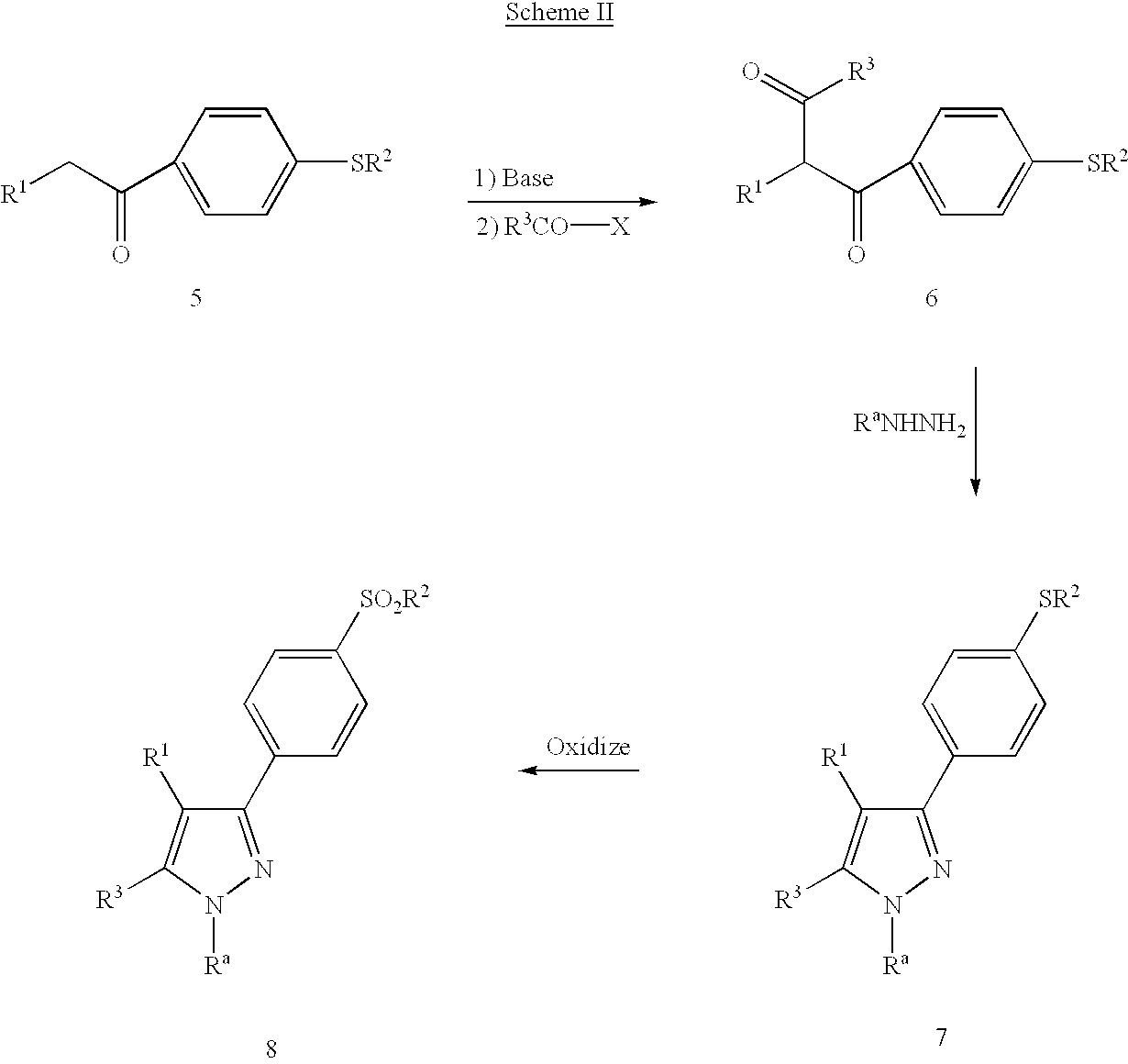Immunosuppressive effects of administration of a cyclooxygenase-2 inhibitor and a 5-lipoxygenase inhibitor
a technology of cyclooxygenase and inhibitor, applied in the field of immunology, can solve the problems of increased malignancy, hair loss, hair loss, and hair loss and the side effects of drugs are often severe, and the effect of affecting the normal cell population is not easy to detect and trea
- Summary
- Abstract
- Description
- Claims
- Application Information
AI Technical Summary
Problems solved by technology
Method used
Image
Examples
example 1
4-[5-(4-Chlorophenyl)-3-(trifluoromethyl)-1H-pyrazol-1-yl]benzenesulfonamide
Step 1: Preparation of 4,4,4-trifluoro-1-[4-(chlorophenyl]-butane-1,3-dione.
[0086]Ethyl trifluoroacetate (23.52 g, 166 mmol) was dissolved in methyl tert-butyl ether (75 mL). To the stirred solution was added 25 weight % sodium methoxide (40 mL, 177 mmol). 4′-Chloroacetophenone (23.21 g, 150 mmol) was dissolved in methyl tert-butyl ether (20 mL) and added to the reaction dropwise. After stirring overnight (15.75 hours), 3N HCl (70 mL) was added. The organic layer was collected, washed with brine (75 mL), dried over MgSO4, filtered, and concentrated in vacuo to give a yellow-orange solid. The solid was recrystallized from isooctane to give the dione (31.96 g, 85%): mp 66–67° C.
Step 2: Preparation of 4-[5-(4-chlorophenyl)-3-(trifluoromethyl)-1H-pyrazol-1-yl]benzenesulfonamide.
[0087]4-Sulphonamidophenyl hydrazine hydrochloride (982 mg, 4.4 mmol, 1.1 equiv.) was added to a stirred solution of 4,4,4-trifluoro-1-[...
example 2
4-[5-(3-Fluoro-4-methoxyphenyl)-3-(difluoromethyl)-1H-pyrazol-1-yl]benzenesulfonamide
Step 1: Preparation of 3′-fluoro-4′-methoxy-acetophenone.
[0088]Acetyl chloride (51.0 g, 0.65 mol) was added dropwise to a stirred solution of aluminum chloride (80.0 g, 0.6 mol) and chloroform (750 mL), maintaining the temperature between 5–10° C. The mixture was stirred for 10 minutes at 5° C. before the dropwise addition of 2-fluoroanisole (62.6 g, 0.5 mol). The mixture was stirred at 0–10° C. for 1 hour and poured into ice (1 L). The resultant layers were separated and the aqueous layer was extracted with dichloromethane (2×250 mL) The combined organic layers were washed with water (2×150 mL), dried over anhydrous MgSO4, filtered and concentrated in vacuo to a volume of 300 mL. Hexanes were added and a white solid formed which was isolated by filtration and air dried. This material was recrystallized from a mixture of dichloromethane and hexanes to afford material suitable for use in the next ste...
example 3
N′-[3-[5-(4-Fluorophenoxy)furyl-2-yl]-1-methyl-2-propynyl]-N′-hydroxyurea
[0091]N-[3-[5-(4-Fluorophenoxy)furyl-2-yl]-1-methyl-2-propynyl]-N′-hydroxyurea was synthesized as described in WO document 92 / 01682: Anal. Calc'd. for C15H13N2O4F: C, 59.21, H, 4.31, N, 9.21. Found: C, 58.93, H, 4.32, N, 9.07.
[0092]The combinations of the invention were evaluated as described in the following tests.
Transplantation and Evaluation of Graft Resection
[0093]The method of skin grafting used has been previously described [D. Steinmuller, Skin Grafting. Surgical Techniques in Immunology, Methods Enzymol. 108, 20 (1984)]. Briefly, a tailskin from an 8–12 week old male B10.Br mouse was removed and stored in cold saline. Male C57BL / 10 mice were anesthetized, and their backs were shaved. The backs were scrubbed with alcohol, and a 1 cm2 piece of skin was removed. A similar size piece of skin was cut from the tailskin of the B10.Br mouse and placed in the excised area on the C57BL / 10 an...
PUM
| Property | Measurement | Unit |
|---|---|---|
| Fraction | aaaaa | aaaaa |
| Fraction | aaaaa | aaaaa |
| Fraction | aaaaa | aaaaa |
Abstract
Description
Claims
Application Information
 Login to View More
Login to View More - R&D
- Intellectual Property
- Life Sciences
- Materials
- Tech Scout
- Unparalleled Data Quality
- Higher Quality Content
- 60% Fewer Hallucinations
Browse by: Latest US Patents, China's latest patents, Technical Efficacy Thesaurus, Application Domain, Technology Topic, Popular Technical Reports.
© 2025 PatSnap. All rights reserved.Legal|Privacy policy|Modern Slavery Act Transparency Statement|Sitemap|About US| Contact US: help@patsnap.com



